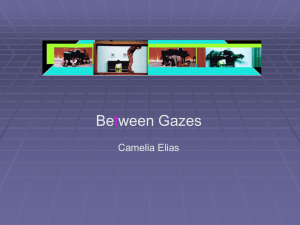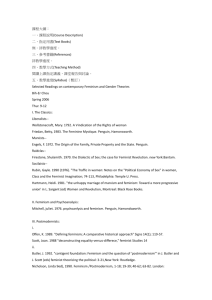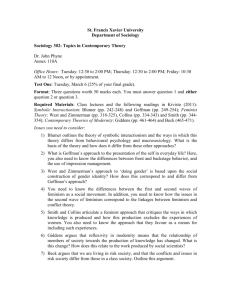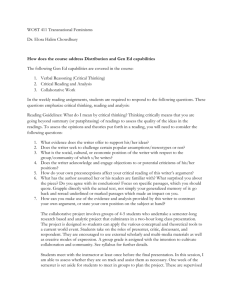barat-popular-culture-2014-15-winter
advertisement
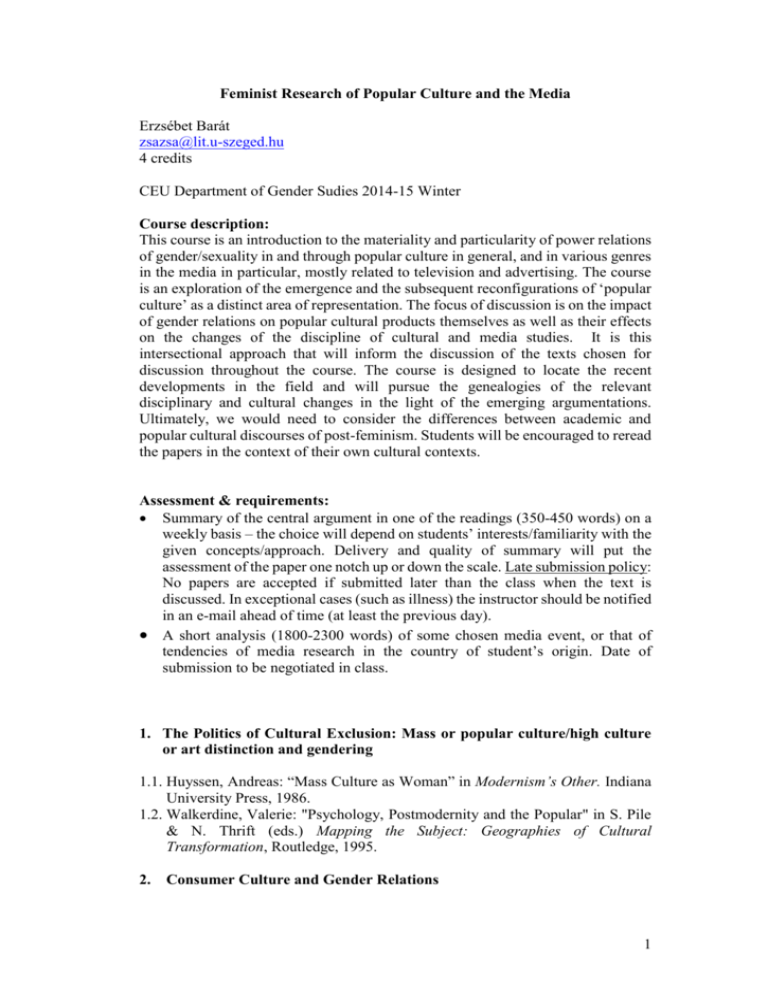
Feminist Research of Popular Culture and the Media Erzsébet Barát zsazsa@lit.u-szeged.hu 4 credits CEU Department of Gender Sudies 2014-15 Winter Course description: This course is an introduction to the materiality and particularity of power relations of gender/sexuality in and through popular culture in general, and in various genres in the media in particular, mostly related to television and advertising. The course is an exploration of the emergence and the subsequent reconfigurations of ‘popular culture’ as a distinct area of representation. The focus of discussion is on the impact of gender relations on popular cultural products themselves as well as their effects on the changes of the discipline of cultural and media studies. It is this intersectional approach that will inform the discussion of the texts chosen for discussion throughout the course. The course is designed to locate the recent developments in the field and will pursue the genealogies of the relevant disciplinary and cultural changes in the light of the emerging argumentations. Ultimately, we would need to consider the differences between academic and popular cultural discourses of post-feminism. Students will be encouraged to reread the papers in the context of their own cultural contexts. Assessment & requirements: Summary of the central argument in one of the readings (350-450 words) on a weekly basis – the choice will depend on students’ interests/familiarity with the given concepts/approach. Delivery and quality of summary will put the assessment of the paper one notch up or down the scale. Late submission policy: No papers are accepted if submitted later than the class when the text is discussed. In exceptional cases (such as illness) the instructor should be notified in an e-mail ahead of time (at least the previous day). A short analysis (1800-2300 words) of some chosen media event, or that of tendencies of media research in the country of student’s origin. Date of submission to be negotiated in class. 1. The Politics of Cultural Exclusion: Mass or popular culture/high culture or art distinction and gendering 1.1. Huyssen, Andreas: “Mass Culture as Woman” in Modernism’s Other. Indiana University Press, 1986. 1.2. Walkerdine, Valerie: "Psychology, Postmodernity and the Popular" in S. Pile & N. Thrift (eds.) Mapping the Subject: Geographies of Cultural Transformation, Routledge, 1995. 2. Consumer Culture and Gender Relations 1 2.1. Thornham, Sue: “Identity Shopping: Women and Consumer Culture” in Feminist Theory and Cultural Studies, Arnold, 2000. 2.2. Lury, Celia: “Habitat and Habits” in Consumer Culture. Polity Press, 1996 . 2 3. Institutional Strategies of Culturally Mediated power 3.1. John Storey: “Popular Culture as Popular or Mass Art” in Inventing Popular Culture. Blackwell, 2003. 3.2. Smith, Dorothy: “Femininity as Discourse” in Texts, Facts, and Femininity. Routledge, 1995. 4. Representation of Women in and through Media Images 4.1. Hall, Stuart: "Encoding/Decoding." S. During (ed.), The Cultural Studies Reader. London and NY: Routledge. 1993. 4.2. Thornham, Sue: “Fixing into Images” in Women, Feminism, and Media. Edinburgh University Press, 2007. 5. Subcultures, Fashion and Age 5.1. Holland, Samantha: “Background Reading” and 5.2. “Categories of Unconventional” in Alternative Femininities. Berg, 2004. 6 -7. Genre and Gender: Feminization 6.1. Judith Mane: “L.A. Law and prime-time feminism” in Framed. Lesbians, Feminists, and Media Culture. University of Minnesota, 2000. 6.2. Probyn, Elspeth: “New Traditionalism and Postfeminism: TV Does the Home” in C. Brunsdon et al. (eds.) Feminist Television Criticism: A Reader. Clarendon Press, 1997. 7.1. Brunsdon, Charlotte: “The feminist in the kitchen: Martha, Martha and Nigella” in Joanne Hollows and Rachel Moseley (eds.) Feminism in Popular Culture. Berg, 2006. 7.2. Negra, Diane: “Structural Integrity, Historical Reversion, and the Post-9/11 Chick Flick”, in Feminist Media Studies, Vol. 8, No 1, March 2008, pp. 51-68. 8. (Im)possibility of participation: Feminism on TV? 8.1. Gil, Rosalind: “Talk-shows: Feminism on TV?” in Gender and the Media. Polity Press, 2007. 8.2. Hellman, H: “Legitimations of Television Programme Policies: Patterns of Argumentations and Discursive Convergences in a Multi-channel Age” in Petri Alasuutari: Rethinking the Media Audience. Sage, 1999. 3 9. Cultural Citizenship and the Media 9.1.Van Zoonen, Liesbet: “ Politics as Soap Opera” and 9.2. “Connections: The Fan Democracy” in Entertaining the Citizen: When Politics and Popular Culture Converge. Rowman and Littlefield Publishers, Inc. 2005. 10. Contesting Post-feminism 10.1. Gorton, Kristyn: “The Politics of Equity and the Media: The Example of Feminism” in Elizabeth Deeds Ermath (ed.) Rewriting Democracy: Cultural Politics in Postmodernity. Ashgate, 2007. 10.2. McRobbie, Angela: “Top Girls? Young Women and Post-Feminist Symbolic Violence” in The Aftermath of Feminism. Sage, 2009. 11. Discussion of Students’ seminar papers. 12. Disorders and Body Image 11.1. Whelehan, Imelda: “Identity crisis?: ‘Post-feminism’, the Media and ‘Feminist Superstars’” in Modern Feminist Thought: From Second Wave to ‘PostFeminism’. Edinburgh University Press, 1995. 11.2. McRobbie, Angela: “Illegible Rage: Post-Feminist Disorders” in The Aftermath of Feminism. Sage, 2009. 4


